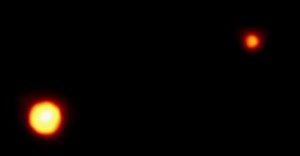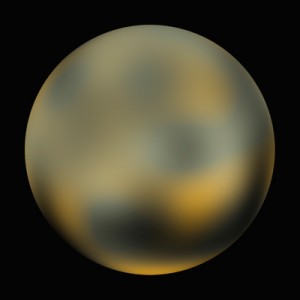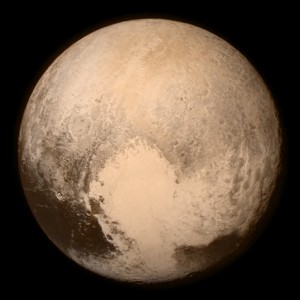Pluto was discovered in 1930 by Clyde Tombaugh, and it was classified the 9th planet from the sun. Until 1994, we didn’t even know exactly how big it was. And the highest-resolution image we had of the planet was this, taken by the Hubble Space Telescope along with its moon, Charon:

In 2010, the Hubble stepped its game up a little bit, sending this picture down to Earth:

And still, Pluto remained the only planet in our solar system to never have been visited by a human spacecraft. We had higher resolution images of Titan – a moon of Saturn – than we did of Pluto. And so, when the definition of “planet” was changed to exclude Pluto in 2006, many people thought we had heard the last of this little dwarf planet.
All of that changed yesterday.
New Horizons
On July 14, 2015, the probe New Horizons passed by Pluto, the climax of a 9-year journey that was launched when the little world was still classified as a planet. And just two days ago, it sent this photo back to us:

Finally, we have a high-definition view of Pluto. And our understanding is only just beginning to grow; it didn’t have the capability to both gather information and send it at the same time. This means that although New Horizons didn’t linger around Pluto (it’s traveling at 37,000 mph; almost as fast as the Voyager I probe, which is whizzing away from the sun at 38,350 mph. This makes it a bit difficult to stop), over the next few months, it will be sending us data in pieces across the giant abyss of space.
Seen Dimly
Pluto’s orbit takes it between 30 and 50 times as far away from the sun as Earth is. It takes over four hours for light to reach it from the sun. The sun itself, it’s estimated, appears only slightly larger than any other star in Pluto’s sky, though clearly brighter. Although New Horizons was the fastest human-propelled vehicle we’ve ever made, it still took almost nine years to arrive. Pluto is one of the furthest places you can get from the sun and still be in the Solar System.
And before this week, we had almost no data on it, except some gravity calculations and a few blurry photos from the Hubble. It reminds me of 1 Corinthians 13:12:
For now we see in a mirror dimly, but then face to face. Now I know in part; then I shall know fully…
We once saw Pluto dimly, both literally and figuratively. (As a side note, do you know how the Hubble Space Telescope works? It enlarges images with a mirror.) But now we have had our face-to-face meeting with the dwarf planet; we understand it far more fully than we ever did. Or we will, once the data finishes downloading.
But the Bible obviously isn’t talking about astronomical bodies; it’s talking about the love of God, and what it means to understand God and His love. 1 Corinthians 13 is known as “the Love Chapter,” and it discusses the great mystery that is God’s love.
But that isn’t the end of the verse.
For now we see in a mirror dimly, but then face to face. Now I know in part; then I shall know fully, even as I have been fully known.
We talked in our last article about the need to make God the Blazing Center of our solar system, the colossal sun around which all of the other planets of our life orbit. But when God is that center, you don’t only know Him… He also knows you.
Despite All of This
“But how can this be? I don’t see how God could love me. I’m evil. He feels so far away. I don’t know how He could love me, if He really knows me.”
1 Corinthians 13 talks about the love of God as persistent and enduring despite all sin and distance; whether we can see Him or not, just like the sun from Pluto, He’s still there. That powerful knowledge, understanding and love continues to hold us in orbit around His perfect love. Like the author of Romans noted,
For I am sure that neither death nor life, nor angels nor rulers, nor things present nor things to come, nor powers, nor height nor depth, nor anything else in all creation, will be able to separate us from the love of God in Christ Jesus our Lord.
And like Pluto, which continues its orbit of our sun whether we call it a planet or not, God continues to hold on to us, no matter what the world calls us. His love is stronger than our distance, and stronger than our sin.
Because God sent His son as a probe to know us better. And instead of just breezing by on His way, He stopped to stay with us, learning about who we are and calling us back to that bright star in the distance, the shining glory of God Himself.
• • •
Thanks for reading Redeeming Culture! If you would like to help us out in our mission to pursue God in culture, please check out our Support page. Thank you!
